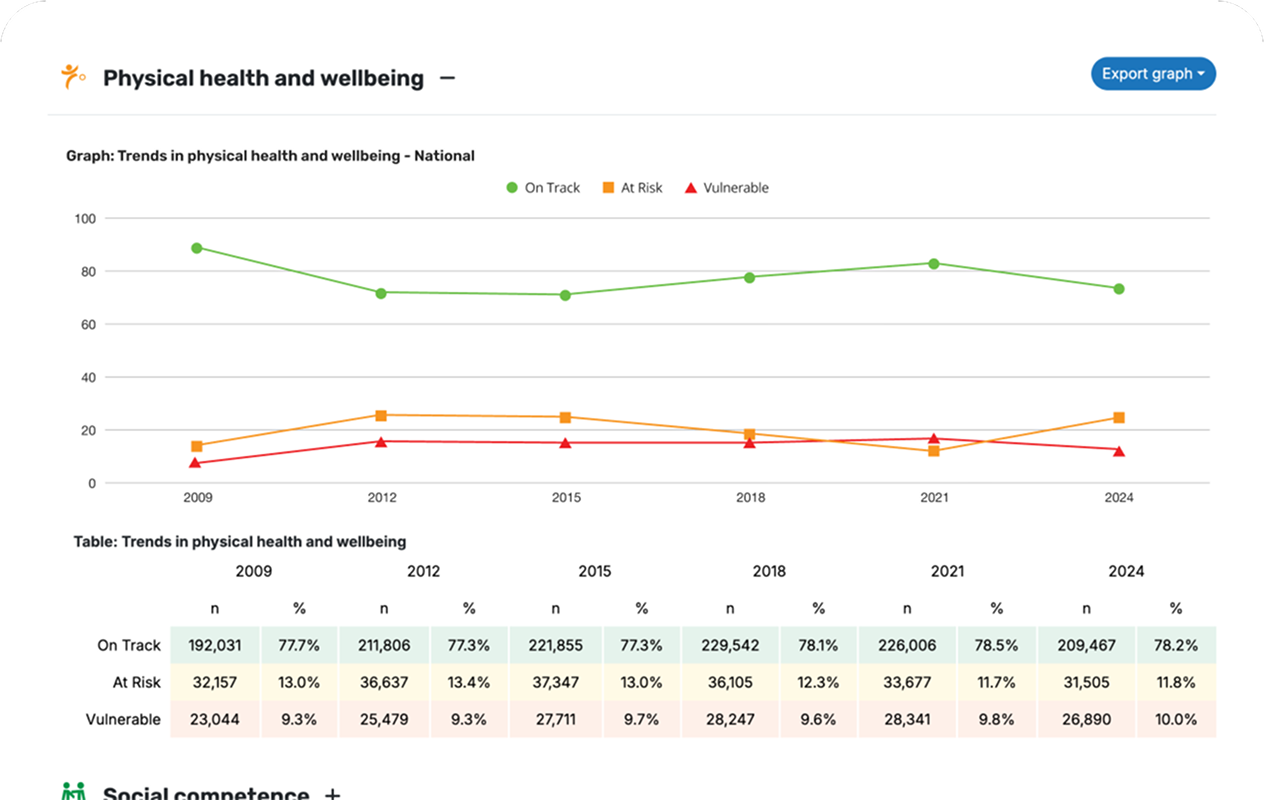
Date: January 2024
AEDC Cycle: Cycle 1 (2009), Cycle 2 (2012), Cycle 3 (2015), Cycle 4 (2018)
States: NSW, QLD
Data Linkage Project: No
Organisation: Parenting and Family Support Centre, School of Psychology, The University of Queensland
The study will investigate the effects of implementing a blending of universal and targeted programs to improve parenting skills and efficacy and contribute to the enhancement of child development outcomes. Specifically, the requested AEDC data will be used to assess whether population-based access to parenting support results in improved outcomes for children across AEDC domains.
Date: December 2019
AEDC Cycle: Cycle 1 (2009), Cycle 2 (2012), Cycle 3 (2015)
States: WA
Data Linkage Project: Yes
Organisation: Curtin University
Children’s development at age five is strongly influenced by social (e.g., young maternal age) and biological (e.g., close birth spacing) factors, from pregnancy. Social and biological risk factors can cluster together (e.g., close birth spacing and prematurity) and accumulate over time (e.g., young maternal age and socio-economic disadvantage). The aim of this study is to investigate the effects of birth spacing, family size and socio-demographic factors on children’s performance on the AEDC at age five. This project is a retrospective cohort study comprising all children born in Western Australia who completed the AEDC in either 2009, 2012 or 2015 in Western Australia. The project will use population-level non-identifiable linked administrative data from three Western Australian administrative datasets (Midwifes Notifications System, Birth Registrations and the AEDC). The linkage of health and education data will advance our understanding about the contributions and interactions between biological and social factors associated with different child development outcomes at age five across the whole population. The use of population-level data to investigate biological and social factors that influence children’s physical, cognitive, language, social and emotional development at age five will shed new light on population groups who are at risk for developmental vulnerability, from pregnancy. The outcomes will help guide health and education policies to support children’s health, development and education.
Date: August 2017
AEDC Cycle: Cycle 1 (2009), Cycle 2 (2012), Cycle 3 (2015)
States: WA
Data Linkage Project: Yes
Organisation: Telethon Kids Institute
In Australia, it has been reported that 61 per cent of women who were victims of intimate partner violence (IPV) in their home had children in their care. Children's exposure to IPV includes witnessing and hearing acts first hand, as well as effects of living in the aftermath of in the incident(s). Whilst many studies have investigated the impact of IPV on women, few have been able to study the impact that exposure to IPV has on outcomes for children also living in the home.
This study uses linked population-based administrative data, including data from AEDC and Western Australian Police, Health, Education, Child Protection and Corrective Service, to examine multiple outcomes for children exposed to IPV, address any existing gaps in the literature and importantly, have the potential to impact policy and practice at the state and national levels.
Date: September 2015
AEDC Cycle: Cycle 1 (2009), Cycle 2 (2012)
States: QLD
Data Linkage Project: Yes
Organisation: Logan Together Project and Griffith University
This project will conduct individual level, area-level and multi-level analyses of the relationships between key indicators of developmental vulnerability and a variety of family background and community contextual indicators in the Brisbane and Logan areas in Queensland. The project is especially interested in testing a range of relationships and causal pathways at the individual and SA1 levels suggested by initial analyses at the SA2 level, especially in those parts of Brisbane and Logan SA2's with very high levels of vulnerability and associated risk and protective factors across a broad spectrum of key measures of child health and wellbeing. A range of statistical procedures will be employed, including cluster analysis, factor analysis (exploratory and confirmatory), multiple regression and structural equation modeling. The results of the analyses will inform decision making by a large consortium of state, local and Commonwealth government agencies and service-providing NGOs.
Date: August 2015
AEDC Cycle: Cycle 2 (2012)
States: ACT, NSW, NT, QLD, SA, TAS, VIC, WA
Data Linkage Project: No
Organisation: Crawford School of Public Policy, ANU
This study undertaken by the Crawford School of Public Policy at the Australian National University examines the relationship between family payments policy and early childhood outcomes. Using the 2012 AEDC data and a range of demographic and socio-economic variables, the research focuses on the Baby Bonus policy to assess whether there is any evidence of such policies influencing early childhood development.
Date: May 2015
AEDC Cycle: Cycle 1 (2009), Cycle 2 (2012)
States: NT
Data Linkage Project: No
Organisation: Centre for Aboriginal Economic Policy Research
This research aims to identify and analyse the extent of changes in the indicators of child health and wellbeing across a range domains such as health and nutrition, child protection, education participation, performance and readiness since the introduction of New Income Management (NIM) in the Northern Territory.
Date: May 2015
AEDC Cycle: Cycle 1 (2009), Cycle 2 (2012)
States: WA
Data Linkage Project: Yes
Organisation: Telethon Kids Institute
Children who experience maltreatment are at a higher risk of poor mental health, education and juvenile justice outcomes. However, new research is emerging which indicates that children’s family circumstances prior to maltreatment may be a stronger predictor of outcomes. This research investigates the role of familial risk factors and type of maltreatment in increasing risk of poor outcomes for children. The study will also identify and monitor risk and resilience factors that may increase or reduce vulnerability to child maltreatment. It also examines whether being placed in out-of-home care or remaining in the family home effects children’s outcomes.
By understanding the risk and protective factors at the child, family and community level it is possible to identify areas of need for early intervention/prevention.
Community Data Explorer
Navigate the AEDC Community Data Explorer and understand the data.
